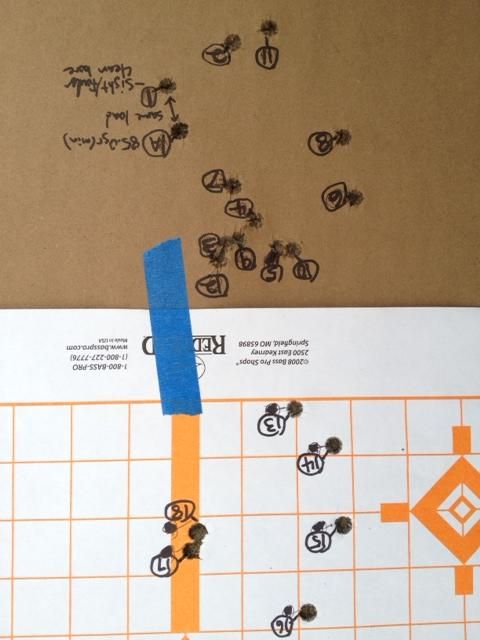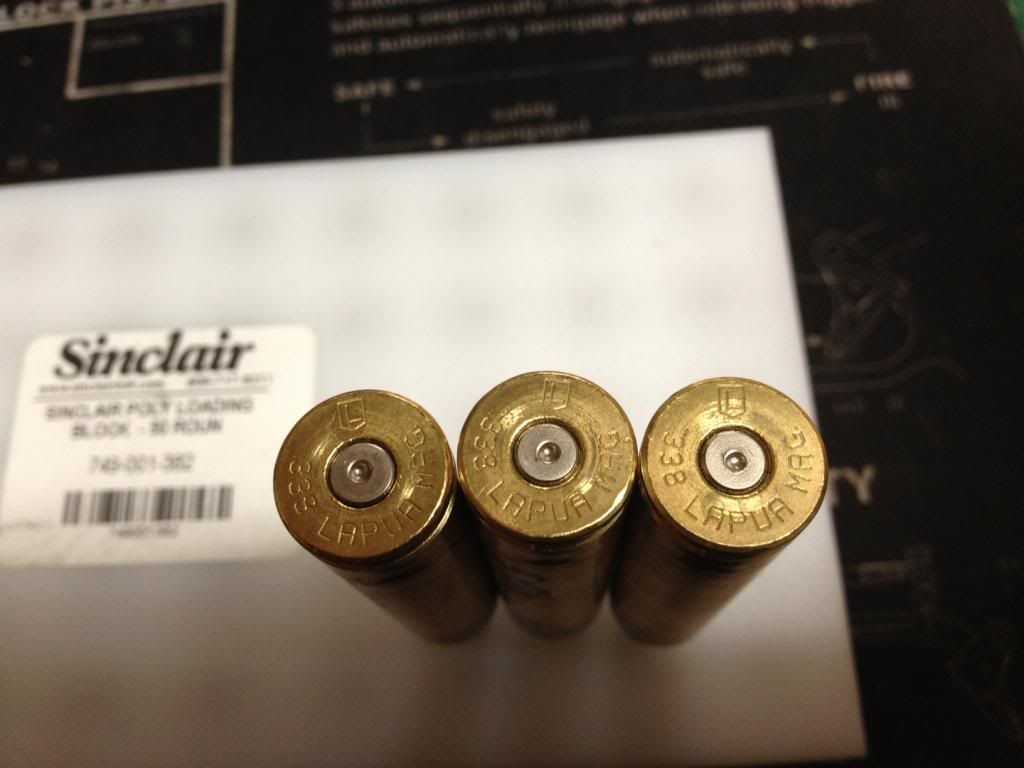I need experienced opinions on this ladder test I ran today since I've never run one before. Any help would be appreciated. Here are the details on the specifics:
Rifle: Savage 110 FCP HS Precision, .338 LM
Load: Lapua brass, CCI 250 primer, Sierra MK 300 gr. bullet, Retumbo powder
Target Distance: 300 yds.
Conditions: 76 deg. F, Winds - Quartering-to-direct tailwind @ 12-13 Kts
I began at the Hodgdon-listed minimum load of 85.0 gr. and progressed in 1.0 gr. increments up to 88.0 gr, then, beginning with load #5 @ 88.5 gr, progressed from there in 0.5 gr. increments all the way up past the book-listed maximum load of 94.0, finally ending on 95.0 gr. No real evidence of excessive pressure was noted except for a slight bit of cratering around the firing pin indentation on the last 2 or 3 rounds (no primer flattening, no ejector marks, no hard bolt lifts, etc. were noted).
I'm not experienced with spotting nodes, but I'll throw out what I think I see on the paper, and ask for your advice on my interpretation. The first potential node I think I see occurs with loads 9, 10, and 12. Oddly, load #11 dropped to the bottom of the paper, and I can only guess I pulled it, but it felt good at the time. MVs for this string are as follows: 9 = 2633, 10 = 2672, 11 = 2663, and 12 = 2683.
The next potential node I think I see occurs with loads 13 and 14. There's a significant hop from 12 to 13, but then 13 and 14 fall within about 1/2 in. of each other vertically. MVs are 13 = 2698, 14 = 2727.
Finally , there appears to be another node @ 17 and 18. Both these loads are above the "book" max of 94.0 gr., with 17 @ 94.5, and 18 @ 95.0. MVs are 17 = 2785, 18 @ 2800. I also found it interesting that the lowest-power loads, and the highest-power loads landed on the same windage plane as the aimpont, while all others in-between landed to the left to varying degrees.
So, what to do with this info? The lowest node (9, 10, 12) falls a little below the MV level that I'd like to achieve, but seems to have some real accuracy potential. The middle node is about where I'd like to run (around 2700), but may not quite have the accuracy potential of the others. And finally, the upper node with the final two shots is potentially impressive, but I wonder if I'd be burning up the barrel and brass at an excessive rate running things that hot?
I'm really looking for advice on my next move. Any advice is much appreciated. I'm also posting this on the Long Range Hunting site for additional insight. Thanks!

Rifle: Savage 110 FCP HS Precision, .338 LM
Load: Lapua brass, CCI 250 primer, Sierra MK 300 gr. bullet, Retumbo powder
Target Distance: 300 yds.
Conditions: 76 deg. F, Winds - Quartering-to-direct tailwind @ 12-13 Kts
I began at the Hodgdon-listed minimum load of 85.0 gr. and progressed in 1.0 gr. increments up to 88.0 gr, then, beginning with load #5 @ 88.5 gr, progressed from there in 0.5 gr. increments all the way up past the book-listed maximum load of 94.0, finally ending on 95.0 gr. No real evidence of excessive pressure was noted except for a slight bit of cratering around the firing pin indentation on the last 2 or 3 rounds (no primer flattening, no ejector marks, no hard bolt lifts, etc. were noted).
I'm not experienced with spotting nodes, but I'll throw out what I think I see on the paper, and ask for your advice on my interpretation. The first potential node I think I see occurs with loads 9, 10, and 12. Oddly, load #11 dropped to the bottom of the paper, and I can only guess I pulled it, but it felt good at the time. MVs for this string are as follows: 9 = 2633, 10 = 2672, 11 = 2663, and 12 = 2683.
The next potential node I think I see occurs with loads 13 and 14. There's a significant hop from 12 to 13, but then 13 and 14 fall within about 1/2 in. of each other vertically. MVs are 13 = 2698, 14 = 2727.
Finally , there appears to be another node @ 17 and 18. Both these loads are above the "book" max of 94.0 gr., with 17 @ 94.5, and 18 @ 95.0. MVs are 17 = 2785, 18 @ 2800. I also found it interesting that the lowest-power loads, and the highest-power loads landed on the same windage plane as the aimpont, while all others in-between landed to the left to varying degrees.
So, what to do with this info? The lowest node (9, 10, 12) falls a little below the MV level that I'd like to achieve, but seems to have some real accuracy potential. The middle node is about where I'd like to run (around 2700), but may not quite have the accuracy potential of the others. And finally, the upper node with the final two shots is potentially impressive, but I wonder if I'd be burning up the barrel and brass at an excessive rate running things that hot?
I'm really looking for advice on my next move. Any advice is much appreciated. I'm also posting this on the Long Range Hunting site for additional insight. Thanks!




